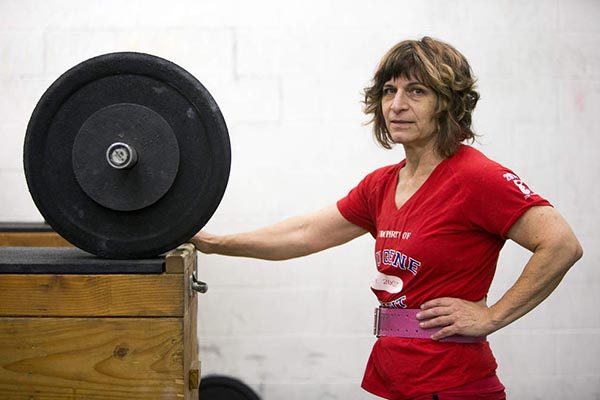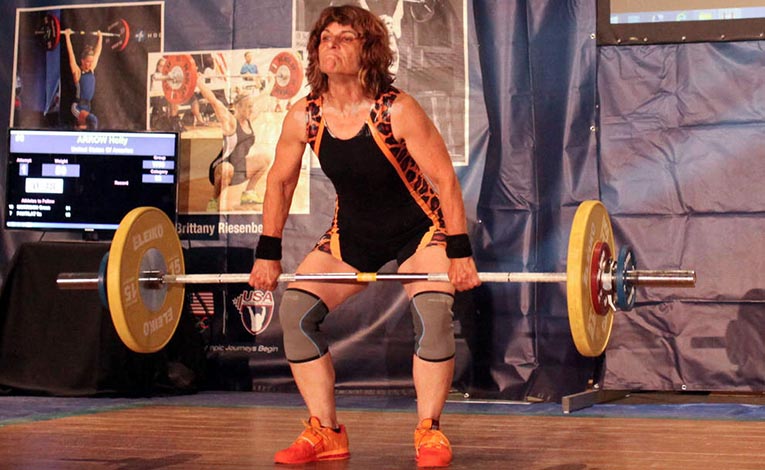At an age when many people are thinking about retirement, Holly Arrow is thinking about her next clean and jerk.
“Alright, let’s go, Holly!” instructor Jessica Gee barks as the 60-year-old psychology professor takes a 95-pound barbell and weights from the ground to above her shoulders (the clean).
Arrow’s right foot swings out, and the weights “jerk” toward the ceiling before she lets them crash and bounce on the floor.
“Physically, I’m in the best shape of my life,” says Arrow, who has taught psychology at the University of Oregon since 1996. “I have a lot of stamina, and I’m strong.
“I’m as strong as I’ve ever been in my life.”
So strong that a little more than five years after taking up CrossFit and Olympic-style weightlifting, she’s not only in great shape, she’s a world champion.
Last August, competing in the 60-to-64 age group at the International Weightlifting Federation Masters World Cup in Dallas, Texas, Arrow set world age-group records in her 138-pound weight class in the two Olympic weightlifting events: snatch, and clean and jerk.
She snatched 47 kilograms (103 pounds) and lifted 64 kilograms (141 pounds) in the clean and jerk, for a total age-group and weight-class record of 114 kilograms (251 pounds).
So, yes, she can clean and jerk more than her own weight.
And you might want to think twice about turning your homework in late for one of her classes, in which she specializes in teaching the psychology of group dynamics and the psychology of war, even if she is older than most students’ parents.
Actually, most of her students think all of this is “pretty cool,” Arrow says with a laugh.
The 103-pound snatch she did in Dallas isn’t even her record.
Arrow said she snatched 51 kilograms (112 pounds) in Monrovia, Calif., last spring at the USA Masters Weightlifting Championships.
“Weightlifting has basically cured me.”

“I was weak and slow”
She’s talking about the day in 2010 that a doctor told her she had osteopenia, a condition in which bone mineral density is lower than normal.
“But my mother had full-blown osteoporosis, where she would fall and break a bone,” Arrow says during a recent workout at Eugene CrossFit near Valley River, the gym she joined in late 2010.
Seeing what it had done to her mother — who is fine today at 84 and keeps her condition under control by still working out at the Y in Rochester, N.Y. — Arrow didn’t want any part of osteoporosis.
She could take medication and change her diet, and she did, but “I also needed weight-bearing exercise,” Arrow says.
A couple of colleagues in the UO Psychology Department recommended Eugene CrossFit.
The CrossFit program was created in 2000 by former husband and wife Greg Glassman and Lauren Jenai. The trademarked program combines high-intensity interval training, Olympic weightlifting, gymnastics, calisthenics and other exercises into daily regimens known as WODs — workouts of the day.
“And, when I first started, I was weak and slow,” Arrow says.
Arrow couldn’t even do a single pull-up, not unusual for someone in their mid-50s.
It took about three months, but when she could do one it “was a big deal,” Arrow says.
And now? Well, besides setting world age-group weightlifting records, she can do “double unders” — twice whipping a jump rope under her feet before they return to Earth.
Oh, and handstand push-ups, which she gladly demonstrated for a Register-Guard reporter and photographer, doing a few against the wall of a workout room at Eugene CrossFit.

“Getting better”
Before discovering CrossFit, Arrows says she was “gracefully accepting what comes with age.”
“Once I started doing CrossFit, I completely exited that frame of mind. I basically became a teenager again. I’d get in the shower and go, ‘Woah.’
“There’d be new muscles. And I’d look forward to getting better.”
A typical schedule has Arrow working out five times a week, every day but Wednesday and Thursday, her rest days .
Arrow does 11/2 hours of CrossFit on Mondays, Tuesdays and Fridays. Those workouts include such gymnastics exercises as ring dips, handstand push-ups, rope climbs and body weight exercises (pull-ups, box jumps, burpees, wall balls) and cardio such as rowing, sprinting or jump-rope.
Arrow does an hour of Olympic weightlifting on Tuesdays and Friday.
Saturday, she does cardio at home or hits the ski slopes in the wintertime, or maybe a hike or workout on a rowing machine.
Sundays include an hour of Olympic weightlifting and an hour of CrossFit.
Since its founding in 2000 in a Santa Cruz, Calif., gym, the number of CrossFit sites reportedly has grown to more than 13,000 worldwide.
Its workouts have come with controversy, though.
A 2005 story in The New York Times quoted Glassman, the co-founder, as saying: “It can kill you. I’ve always been completely honest about that.”
Glassman was responding to a question about rhabdomyolysis, a potentially life-threatening condition that occurs when broken-down muscle tissue floods the bloodstream.
The Times’ story began with a description of a 38-year-old man in Tacoma engaging in his first CrossFit session by swinging a 44-pound steel ball with a handle over his head and between his legs.
After 30 minutes, he reportedly left the gym with his muscles sapped and excruciating back pain. He wound up in an emergency room with rhabdomyolysis and spent six days in intensive care.
Now so popular it has its own annual, ESPN-televised CrossFit Games (which Arrow has competed in), CrossFit insists in many news reports that its workouts are safe if performed under the supervision of certified trainers.

Arrow teaches, too
As for Arrow, who is now teaching CrossFit to a group of older women, she says she’s had few issues with it. “People can get injured doing CrossFit,” she says. “In many activities, however, you don’t have a coach leading you and guiding you and doing their best to protect you from your own foolishness.
“In general, I think a (CrossFit) box is a safer place than many places people work out unsupervised and definitely less injury prone than distance running,” she says.
Arrow started CrossFit five years ago with some chronic right shoulder pain, which ironically came from an injury sustained doing, get this, the Wii Fit workout. Yes, Nintendo’s video game workout strained her shoulder while she was pretending to fly like a penguin, Arrows says, rolling her eyes.
She’s undergone some chiropractic work on the shoulder and deals with it.
“It’s never come back 100 percent,” she says.
Arrow also has had some hamstring issues from sprinting workouts.
Asked, while doing back squats with more than 200 pounds on her shoulders, if she’s had any back pain, Arrow says no.
“As long as you do it with good form, it makes your back stronger,” she says. Then she tries three reps with 205 pounds.
Arrow’s face grows red with strain and grimace as she eases into the first rep, but the second one isn’t happening. She lets the weights go, pushing the barbell off her back as it thuds and bounces on the floor.
Arrow’s weightlifting numbers are, amazingly, still increasing, she says.
“I can continue to get better, because I’m strong enough to lift more,” Arrow says. “But I’m probably not going to run faster.
“I’m 60 now. I’m working against a headwind, but I’m still making progress.”
Courtesy of: The Register-Guard
